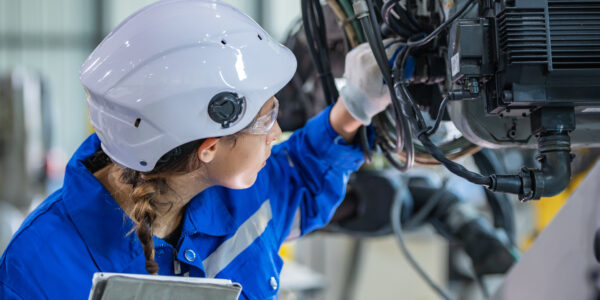AI holds plenty of promise for manufacturing, but getting from abstract promise to actual use cases may take a while. One way AI can play a significant role in enhancing workplace safety in factories is by working with personal wearables to identify and ameliorate hazardous conditions and habits. Here’s how this can be achieved:
- Data Collection with Wearables:
- Provide factory workers with wearable devices such as smart helmets, smart glasses, or smart vests equipped with various sensors. These sensors can collect data on environmental conditions (temperature, humidity, gas levels), body vitals (heart rate, body temperature), and worker movements (location, posture).
- Real-time Monitoring:
- Use AI algorithms to process the data from wearables in real-time. This allows for immediate detection of hazardous conditions or deviations from safety protocols.
- For example, AI can monitor a worker’s vital signs and detect if they are experiencing heat stress or elevated heart rate, signaling a potential health risk due to excessive heat or exertion.
- Alerts and Notifications:
- Implement an alert system that sends notifications to workers and supervisors when hazardous conditions are detected or when a worker’s vital signs indicate distress.
- Alerts can be delivered through the wearable device or a connected smartphone. They could even be integrated with the factory’s existing communication systems.
- Predictive Analytics:
- Use AI to analyze historical data and predict potential hazards. For instance, it can predict when equipment is likely to fail or when specific tasks are associated with a higher risk of accidents.
- AI can provide recommendations to mitigate these risks, such as adjusting work schedules or performing preventive maintenance.
- Training and Guidance:
- Incorporate AI into wearable devices to provide real-time guidance and training to workers. For example, smart glasses can overlay safety instructions or warnings in a worker’s field of vision.
- AI can also provide audio or visual cues to correct posture or technique when performing physically demanding tasks.
- Data Storage and Analysis:
- Store data collected from wearables in a secure cloud-based system for analysis and reporting. Over time, this data can be used to identify trends, assess the effectiveness of safety measures, and make continuous improvements.
- Machine Learning for Habit Analysis:
- Implement machine learning models to analyze worker behavior and habits over time. This can help identify patterns of non-compliance with safety protocols.
- AI can suggest personalized interventions or training programs to address these habits and improve safety compliance.
- Compliance Tracking:
- Use AI to track and ensure compliance with safety regulations and guidelines. It can automatically generate reports for regulatory bodies and internal audits.
- Human-AI Collaboration:
- It’s essential to strike a balance between automation and human intervention. AI should support human decision-making rather than replacing it entirely. Workers and supervisors should have the final say in critical safety decisions.
By integrating AI with personal wearables and leveraging real-time data analysis, factories can significantly enhance safety measures, reduce accidents, and create a healthier and more secure working environment for their employees. However, it’s crucial to implement these technologies thoughtfully, ensuring that they respect privacy, adhere to regulations, and involve workers in the process to gain their trust and cooperation.



